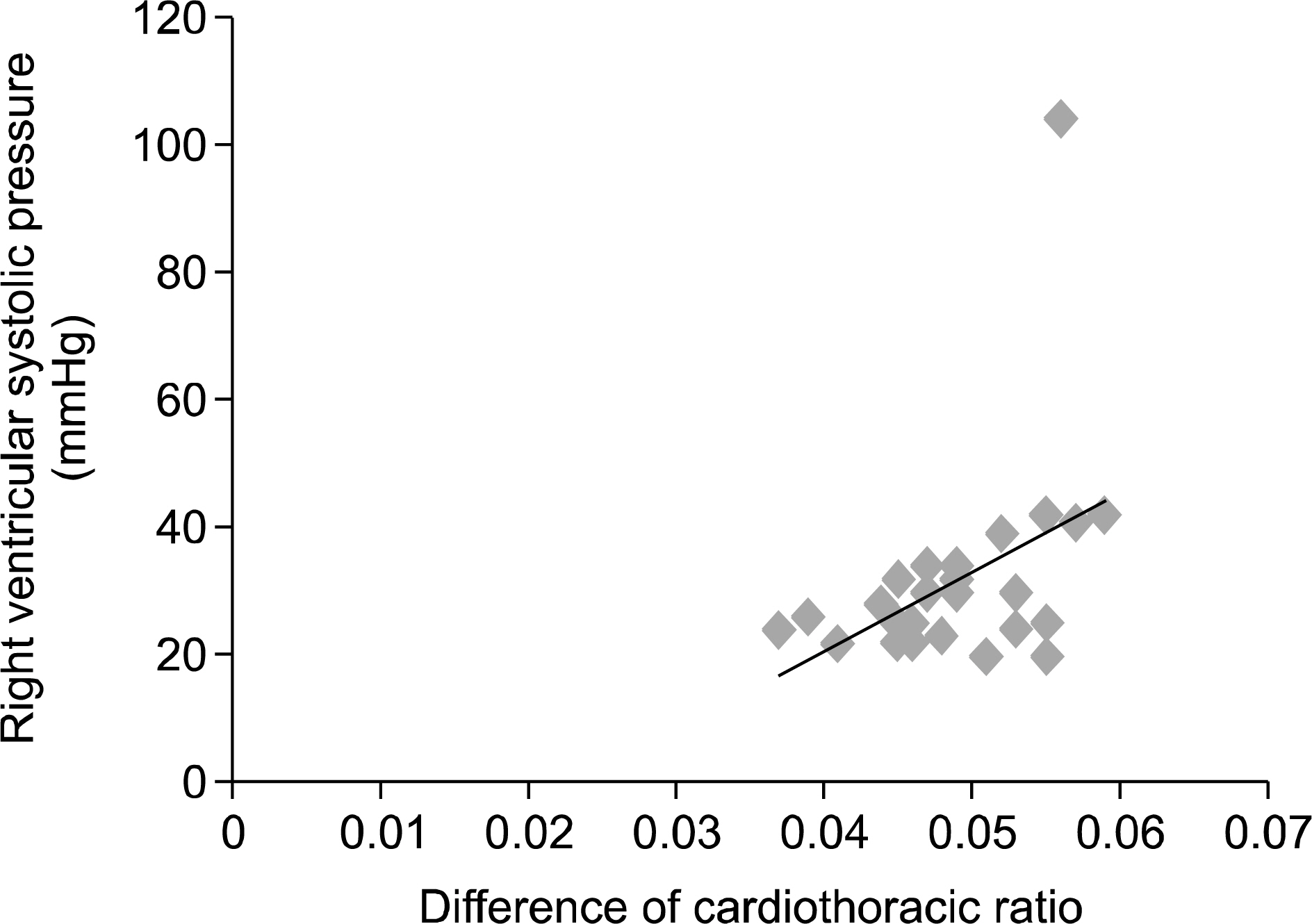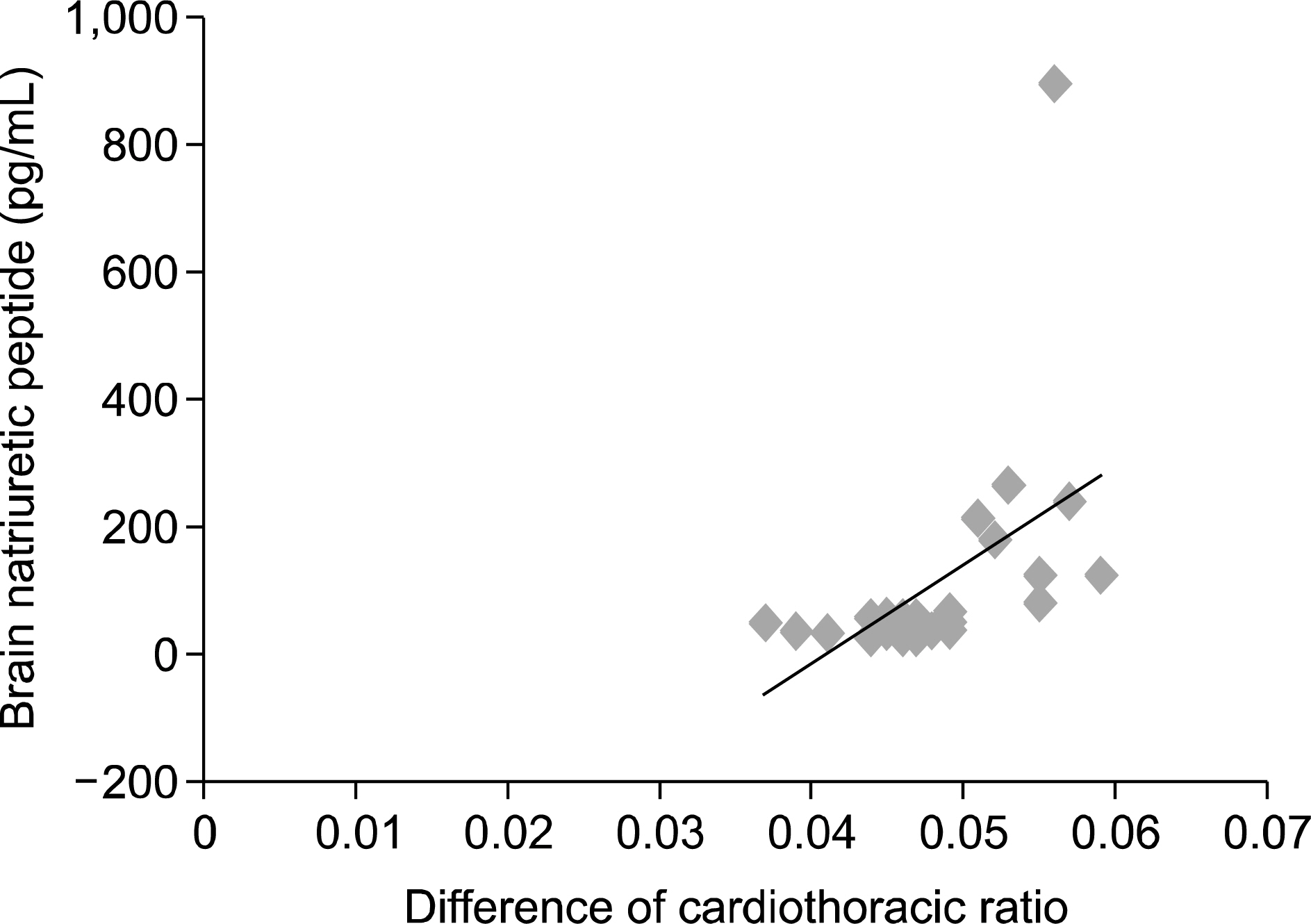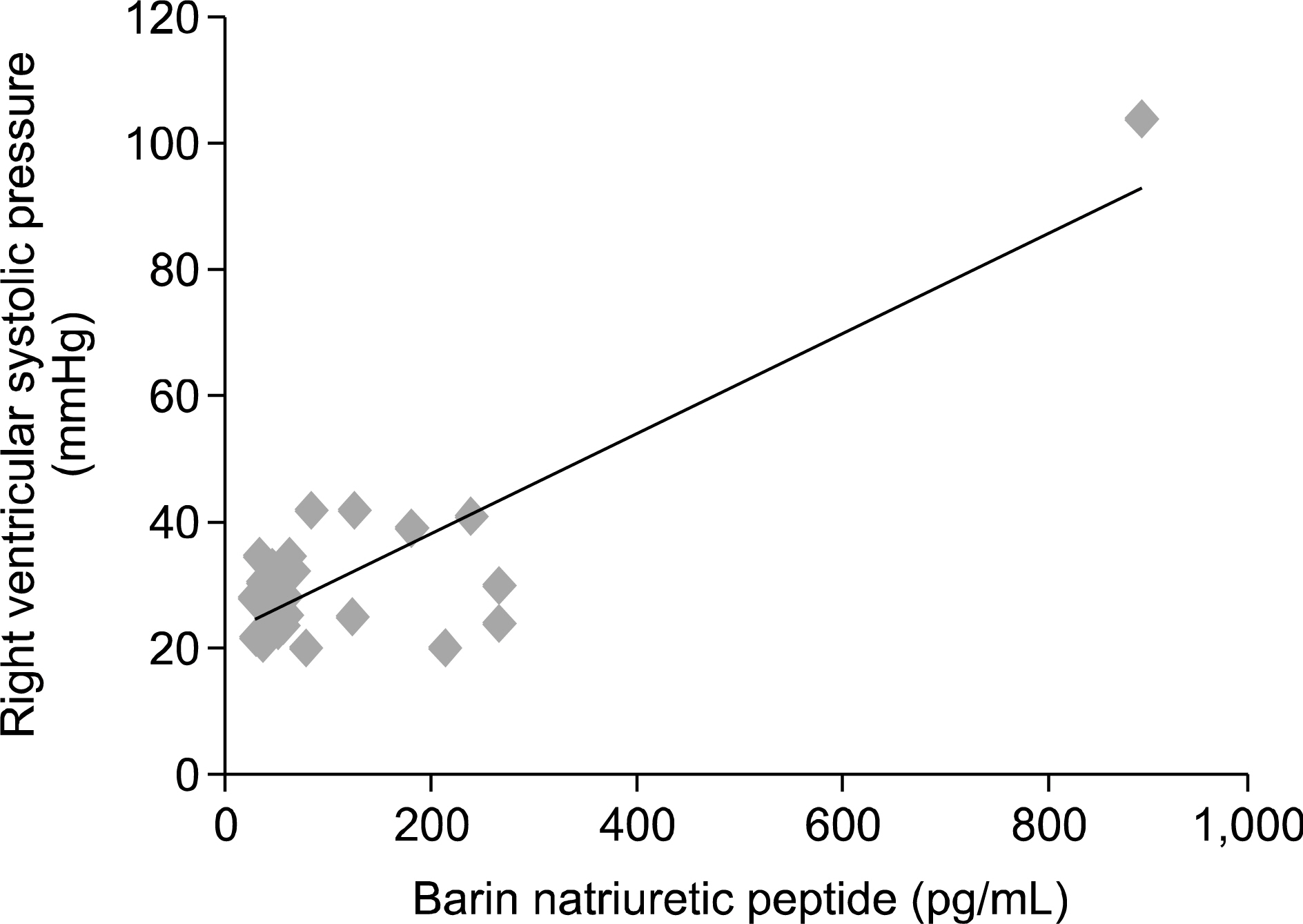J Rheum Dis.
2015 Feb;22(1):19-24. 10.4078/jrd.2015.22.1.19.
Correlation of Cardiothoracic Ratio and Right Ventricular Systolic Pressure in Systemic Sclerosis
- Affiliations
-
- 1Division of Rheumatology, Department of Internal Medicine, Dong-A University College of Medicine, Busan, Korea. leesw@dau.ac.kr
- KMID: 2222922
- DOI: http://doi.org/10.4078/jrd.2015.22.1.19
Abstract
OBJECTIVE
This study was designed to assess sequential association between right ventricular systolic pressure and cardiothoracic (C/T) ratio of chest radiography in systemic sclerosis (SSc) patients and inferred pulmonary arterial hypertension by increased C/T ratio and right ventricular systolic pressure.
METHODS
Twenty-eight consecutive patients with confirmed SSc (22 females, 6 males; mean age 51.1+/-2.1 years), with a mean time of 91.0+/-6.7 months from SSc diagnosis, were prospectively included in the study. C/T ratio was obtained by chest radiography with an interval of two years. The first C/T ratio was taken at diagnosis and second C/T ratio was taken at the time of enrollment. The enrolled subjects were agree to undergo echocardiography and measurement of brain natriuretic peptide.
RESULTS
In 24 SSc patients with normal right ventricular systolic pressure, 10 SSc patients had increased C/T ratio, the other four SSc patients with increased right ventricular systolic pressure by echocardiography, had increased C/T ratio all together. In four SSc patients with increased right ventricular systolic pressure, one patient had resting dyspnea, taken cardiac catheterization and confirmed as pulmonary hypertension and the other three patients had no clinical symptoms. The increased right ventricular systolic pressure is related to the increase of C/T ratio (>0.55) in chest radiography (p<0.05) and increased brain natriuretic peptide in blood (p<0.05).
CONCLUSION
The increase of C/T ratio (>0.55) in chest radiography was associated with increased right ventricular systolic pressure measured by echocardiography and inferred a role in early detection of asymptomatic pulmonary arterial hypertension in SSc patients.
Keyword
MeSH Terms
Figure
Reference
-
1. Hachulla E, Gressin V, Guillevin L, Carpentier P, Diot E, Sibilia J, et al. Early detection of pulmonary arterial hypertension in systemic sclerosis: a French nationwide prospective multicenter study. Arthritis Rheum. 2005; 52:3792–800.
Article2. Komócsi A, Vorobcsuk A, Faludi R, Pintér T, Lenkey Z, Költo G, et al. The impact of cardiopulmonary manifestations on the mortality of SSc: a systematic review and meta-analysis of observational studies. Rheumatology (Oxford). 2012; 51:1027–36.
Article3. Campo A, Mathai SC, Le Pavec J, Zaiman AL, Hummers LK, Boyce D, et al. Hemodynamic predictors of survival in scleroderma-related pulmonary arterial hypertension. Am J Respir Crit Care Med. 2010; 182:252–60.
Article4. Hesselstrand R, Wildt M, Ekmehag B, Wuttge DM, Scheja A. Survival in patients with pulmonary arterial hypertension associated with systemic sclerosis from a Swedish single centre: prognosis still poor and prediction difficult. Scand J Rheumatol. 2011; 40:127–32.
Article5. Humbert M, Yaici A, de Groote P, Montani D, Sitbon O, Launay D, et al. Screening for pulmonary arterial hypertension in patients with systemic sclerosis: clinical characteristics at diagnosis and long-term survival. Arthritis Rheum. 2011; 63:3522–30.
Article6. Fischer A, Bull TM, Steen VD. Practical approach to screening for scleroderma-associated pulmonary arterial hypertension. Arthritis Care Res (Hoboken). 2012; 64:303–10.
Article7. Ngian GS, Stevens W, Prior D, Gabbay E, Roddy J, Tran A, et al. Predictors of mortality in connective tissue disease-associated pulmonary arterial hypertension: a cohort study. Arthritis Res Ther. 2012; 14:R213.
Article8. Preliminary criteria for the classification of systemic sclerosis (scleroderma). Subcommittee for scleroderma criteria of the American Rheumatism Association Diagnostic and Therapeutic Criteria Committee. Arthritis Rheum. 1980; 23:581–90.9. Clements PJ, Lachenbruch PA, Seibold JR, Zee B, Steen VD, Brennan P, et al. Skin thickness score in systemic sclerosis: an assessment of interobserver variability in 3 independent studies. J Rheumatol. 1993; 20:1892–6.10. Distler O, Pignone A. Pulmonary arterial hypertension and rheumatic diseases: from diagnosis to treatment. Rheumatology (Oxford). 2006; 45(Suppl 4):iv22–5.11. Callejas-Rubio JL, Moreno-Escobar E, de la Fuente PM, Pérez LL, Fernández RR, Sánchez-Cano D, et al. Prevalence of exercise pulmonary arterial hypertension in scleroderma. J Rheumatol. 2008; 35:1812–6.12. Ciurzyński M, Bienias P, Lichodziejewska B, Kurnicka K, Szewczyk A, Glińska-Wielochowska M, et al. Non-invasive diagnostic and functional evaluation of cardiac involvement in patients with systemic sclerosis. Clin Rheumatol. 2008; 27:991–7.
Article13. Galiè N, Manes A, Farahani KV, Pelino F, Palazzini M, Negro L, et al. Pulmonary arterial hypertension associated to connective tissue diseases. Lupus. 2005; 14:713–7.
Article14. Trow TK, McArdle JR. Diagnosis of pulmonary arterial hypertension. Clin Chest Med. 2007; 28:59–73.
Article15. Ewald B, Ewald D, Thakkinstian A, Attia J. Meta-analysis of B type natriuretic peptide and N-terminal pro B natriuretic peptide in the diagnosis of clinical heart failure and population screening for left ventricular systolic dysfunction. Intern Med J. 2008; 38:101–13.
Article16. Doust JA, Glasziou PP, Pietrzak E, Dobson AJ. A systematic review of the diagnostic accuracy of natriuretic peptides for heart failure. Arch Intern Med. 2004; 164:1978–84.
Article17. Battaglia M, Pewsner D, Jüni P, Egger M, Bucher HC, Bachmann LM. Accuracy of B-type natriuretic peptide tests to exclude congestive heart failure: systematic review of test accuracy studies. Arch Intern Med. 2006; 166:1073–80.18. Kanemoto N, Furuya H, Etoh T, Sasamoto H, Matsuyama S. Chest roentgenograms in primary pulmonary hypertension. Chest. 1979; 76:45–9.
Article19. Lupi E, Dumont C, Tejada VM, Horwitz S, Galland F. A radiologic index of pulmonary arterial hypertension. Chest. 1975; 68:28–31.
Article
- Full Text Links
- Actions
-
Cited
- CITED
-
- Close
- Share
- Similar articles
-
- A study on computed tomography cardiothoracic ratio in predicting left ventricular systolic dysfunction
- Electrocardiographic and Echocardiographic Analysis in Atrial Septal Defect, Ostium Secundum Type
- A Study on the Echocardiographic Right Ventricular Systolic Time Intervals in Adults
- The Effects of Phenylephrine on Hemodynamics in Patients with Chronic Pulmonary Hypertension Compared to Patients without Chronic Pulmonary Hypertension
- The Effects of Hemodynamic Findings on Development of Pulmonary Vascular Changes in Patients with Ventricular Septal Defect




